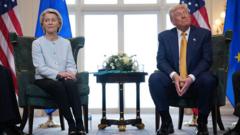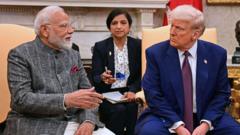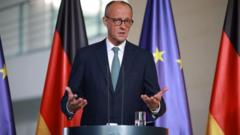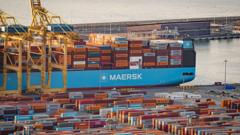Despite a handshake between US President Trump and EU Commission chief Ursula von der Leyen, many European nations are uneasy about the details of the new trade agreement, which subjects most EU exports to a 15% tariff. Leaders hope for further negotiations but warn that significant disparities remain in interpretations of the deal.
EU-US Trade Agreement Faces Uncertainty Amid Discontent and Discrepancies
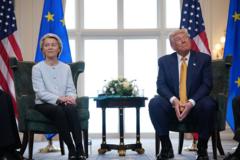
EU-US Trade Agreement Faces Uncertainty Amid Discontent and Discrepancies
European leaders express dissatisfaction with the recent US-EU trade deal terms, raising concerns over its long-term implications and potential economic impact.
The EU recently celebrated a tentative trade agreement with the US, but as many European leaders assess the outcome, there is widespread discontent regarding the terms and clarity of the arrangement. President Donald Trump and European Commission chief Ursula von der Leyen initially shared smiles during the announcement, which came ahead of his self-imposed August 1 deadline. The deal marked a retreat from Trump's earlier threats of a 30% tariff, a shift that provided some relief across Europe, particularly as other nations scramble for similar negotiations with the US.
However, as the dust settles, the feeling among European nations is increasingly aggrieved, with many questioning just how beneficial the agreement truly is. Although the new agreement introduces a 15% tariff on a range of EU exports, up from the previous 4.8% average rate, there is a palpable reluctance to celebrate. Germany's finance minister Lars Klingbeil stated he would have liked a stronger negotiating position, but acknowledged the agreement offers some degree of predictability and stability after several tumultuous months.
Critics within the EU have voiced dissatisfaction with the lack of a finalized joint statement, as representatives indicate the current terms are primarily political commitments rather than legally binding. While the US portrays the agreement as a landmark achievement with "historic structural reforms," officials from both sides have conceded that additional discussions are necessary to clarify operational details.
French President Emmanuel Macron characterized the recent agreement as just the beginning, emphasizing that negotiations on numerous aspects will continue. Experts note that trade agreements can typically take up to two years to finalize, with ongoing negotiations expected to shape future terms.
Discrepancies in the interpretations of the deal have raised further concerns. For instance, while the US states that pharmaceuticals and semiconductors will be subject to the 15% tariff, the EU claims these sectors will maintain their current 0% rate until new global tariff guidelines are established, leaving future rates uncertain.
Moreover, disparities in language surrounding investment commitments have sparked confusion, as the US claims the EU has agreed to a $750 billion investment plan, while the EU suggests only an intention to invest in response to energy needs. The European Union's defense procurement goals also complicate negotiations, as the emphasis on growing domestic defense industry spending contrasts sharply with increased military purchases from the US.
Ultimately, while the new tariffs will broadly impact all EU nations, countries such as Germany, Ireland, and Italy may face the brunt of the consequences due to their economic ties with the US. Experts predict significant financial strain on these nations, with concerns articulating that the deal poses more questions than answers, leaving European negotiators under significant pressure to secure favorable amendments. As discussions persist, the potential for further complications looms large, and speculation about the agreement's feasibility and long-term effects will likely dominate the headlines in the coming months.
However, as the dust settles, the feeling among European nations is increasingly aggrieved, with many questioning just how beneficial the agreement truly is. Although the new agreement introduces a 15% tariff on a range of EU exports, up from the previous 4.8% average rate, there is a palpable reluctance to celebrate. Germany's finance minister Lars Klingbeil stated he would have liked a stronger negotiating position, but acknowledged the agreement offers some degree of predictability and stability after several tumultuous months.
Critics within the EU have voiced dissatisfaction with the lack of a finalized joint statement, as representatives indicate the current terms are primarily political commitments rather than legally binding. While the US portrays the agreement as a landmark achievement with "historic structural reforms," officials from both sides have conceded that additional discussions are necessary to clarify operational details.
French President Emmanuel Macron characterized the recent agreement as just the beginning, emphasizing that negotiations on numerous aspects will continue. Experts note that trade agreements can typically take up to two years to finalize, with ongoing negotiations expected to shape future terms.
Discrepancies in the interpretations of the deal have raised further concerns. For instance, while the US states that pharmaceuticals and semiconductors will be subject to the 15% tariff, the EU claims these sectors will maintain their current 0% rate until new global tariff guidelines are established, leaving future rates uncertain.
Moreover, disparities in language surrounding investment commitments have sparked confusion, as the US claims the EU has agreed to a $750 billion investment plan, while the EU suggests only an intention to invest in response to energy needs. The European Union's defense procurement goals also complicate negotiations, as the emphasis on growing domestic defense industry spending contrasts sharply with increased military purchases from the US.
Ultimately, while the new tariffs will broadly impact all EU nations, countries such as Germany, Ireland, and Italy may face the brunt of the consequences due to their economic ties with the US. Experts predict significant financial strain on these nations, with concerns articulating that the deal poses more questions than answers, leaving European negotiators under significant pressure to secure favorable amendments. As discussions persist, the potential for further complications looms large, and speculation about the agreement's feasibility and long-term effects will likely dominate the headlines in the coming months.







